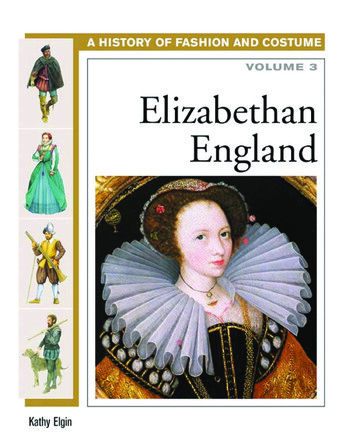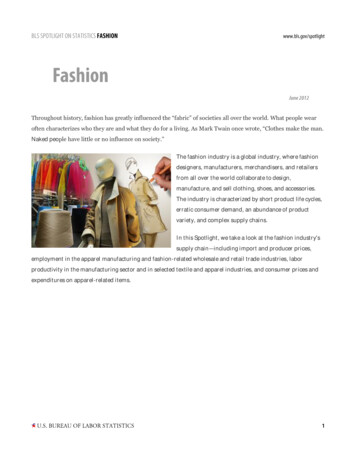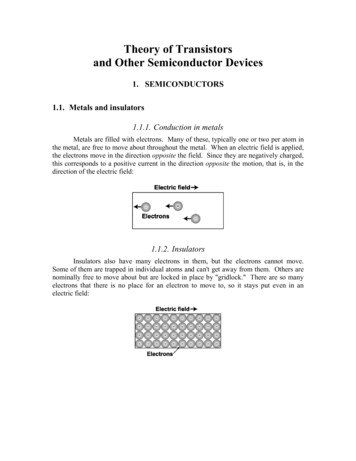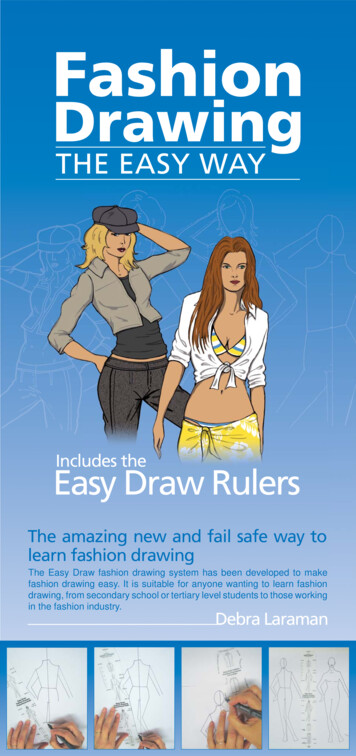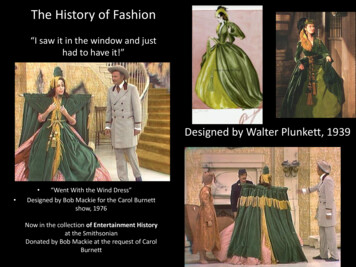
Transcription
The History of Fashion“I saw it in the window and justhad to have it!”Designed by Walter Plunkett, 1939 “Went With the Wind Dress”Designed by Bob Mackie for the Carol Burnettshow, 1976Now in the collection of Entertainment Historyat the SmithsonianDonated by Bob Mackie at the request of CarolBurnett
Questions to leave with: What is fashion? What are the principles of great fashion design? What does fashion mean to you? How can the past and present be interpretedthrough ideas and characteristics of fashion?
Takeaway: Basic principles of design: silhouette; line; color; and texture Basic fabrics used until the 19th century An argument of how fashion relates to and mirrors fine art. Theconnection of fashion to fine art and architecture through the ages The basic classical clothing elements of dress of Egypt, Greece, andRome The ideals of fashion as they were in classical times in AncientEgypt, Greece, and Rome. We will look to see how these idealscarry-on through the ages
Crossover: Fashion and ArtThe Golden Age of Couture:Paris and London 1947-1957
May 4–August 7, 2011
Terms with which to describe fashion:Four Elements of Design LineForm/SilhouetteColorTexture
Silhouette or Shape
Silhouettes
Silhouettes and style lines
Underwear often is the most important element in creatingthe silhouette
Color Wheel
Textures speak volumes about people/charactersCotton/linen/BurlapVelvetSilk Hyacinthe Richaud, Louis in Robes of State, 1701 Anthony Van Dyck, Charles I at the Hunt, 1635 Piero della Francesca, Federico da Montefeltro,1472 Pieter Bruegel, The Peasant Wedding , 1568
The elegance, simplicity, balance, andattention to the human form beginswith the ancients .
Through their attention to silhouette, line, color, andtexture, we begin our story of the history of fashion
Basic Egyptian clothing styles3000 BC-30AD Clothing said to be: roomy, light, and spare. Men and women:Loincloths;wrap around skirts shenti robes/longergarments—made ofrectangular lengthsof cloth Cloaks and shawlslong and short Garments made ofsquares andrectangles of fabric Sashes and strapssandals Women:kalasiris orCalasiris sheathdress
Kalasiris/Calasiris orbead-net sheath dressStatue of an Offering Bearer, Metropolitan MuseumSkills include: beading; pattern weaving, embroidery,appliqueBeadnet dress MFA Boston 2323–2150 B.C.constructed of: faience cylinderbeads, reconstructed
Pyramids at Giza, 25401330 BCWooden statue of the Lady Thuya, 1570-1320 B.B.
ate PeriodAttention given to the genital area in men’s clothing was due to the fact it wasregarded as sacred because of its involvement in procreation
Watercolor by Henry Salt of a painted relief in the early 19th Dynasty tomb of Sety I.Standard symbols used include: water plants, lotus, papyrus, scarab, and the sun disc (Aton)Cobra head Uraeus signified the Pharoah
18th Dynasty1370BCNebamun’s tomb,musicians and dancers,frontal view of facesWith after dinner conedhead melts
Shenti in pyramid shapes & an assortment of headdresses—later Egyptian historylooms that wove ornamental tapestry and patterned fabric date from 1500 BC
Collar / Mantle: gold, carnelian, glassWide collar MantleHorus falcon God, protector of Egyptian PharoahCollars could be made from: Shells Beads Flowers Precious stones set into gold Worn as necklace or setattached to leather or clothneckline Extended over the neck an dshoulders, nine rows of inlaidbeads, on each side is a falconheadReign of Tut, 18th dynastyEgyptians believed in magic: that by representing religious figures in jewelry, the positivequality of the deity would be transferred to the wearer
King Tut’s pectoralsun/ protective vulture wings/ uraeus or cobra/scarab: symbol of life and the solar cycleTwo most prominent types of jewelry: pectoral and collarWeighted in back with counterweight
linen shirt, about 1360 BC Pleated tunic. 1st dynasty,c. 3100-2890 BC. Victoria and AlbertMuseumPetrie Museum, LondonLinen tunicover four thousand yearsold. The Petrie Museumof Egyptian Archaeology.
wears the blue crown Khepreshor called “War Crown” Nefertiti: “A BeautifulWoman has Come” Ruled withAkhenaton, his reign:1352 BC-1336 BC Life: 1367-1336 BCNefertitiC 1350
Pyramids at Giza
What is Classical beauty?Audrey Hepburn, 1961Eiizabeth Taylor as Cleopatra, 1963
Nemes head-dressKing Tut’s, about 1350 B.C.Khat or Klaft headdress
Wedjat eye the Eye ofHorusthe symbol of healing and protectionWorn to protect from:Sun; insect disease; sandProtective amulet. Worn as a populargood luck charm.
Image of Elizabeth Taylor forCleopatra, 1963Costume designIrene Sharaff, Vittorio Nino, NovareseRenieVulture and falcon
Egypt inspiresArt Deco, 19251939
Comparison of ancient statuary: body idealsKing MycerinusandHis Queen2548-2530B.C.E.Statue ofakouros(youth),ca. 590–580 B.C.ArchaicKourosLateArchaic4th centuryBCThe Winged Victory ofSamothracec.220-190 BC, also calledtheNike of Samothrace,
Words to describe Greek idealsexhibited in art and fashion NaturalismHarmonious proportionHarmony in feeling and in formRhythmic harmonySensuousness; lithe proportions; play of gentle curves;sense of relaxationFluidityBalanceInterest in uniting motion and human emotionEase of movementDeeply felt poetry of beingAnimated with an inner life force
Ancient Greece: 800 BC-146 ADadmiration for the human form guided dress4th century BCParthenon, Three goddesses Hestia, Dione, Aphrodite) from the eastpediment, 438-432 BC.Ionic ChitonGreatest temple: The Parthenon built 448-432
Colors could haveincluded: red, blue,yellow, and greenTextiles could havepatterns of: Stylized floralmotifs Geometricpatterns Meander Greek keyDesigns could havebeen:wovenEmbroideredpainted
Chiton:Doric (450-300BC)Ionic (550-300 BC) ;Hellenistic (300-100 BC)Nike of Samothrace, 190BC
Charioteer’s chiton(ky’tn) xystis. His shoulders are seamedvariations from: belting; fold at the top; varying placement of the pinssoft, thin linen cloth compressed with belt into soft columnar folds. Fabricoften pleated
The Doric Chiton or DoricPeplos5th and 6th centuries B.C.
AccessoriesGreeks wore fine and delicate earrings, bracelets, necklaces, brooches, and rings made ofprecious and semi-precious stones. gold was in short supply but increased by 6th century BCThe Ganymede Jewelry, ca. 330–300 B.C.;HellenisticGold, rock crystal, emerald
Olympic VictorPriest of Dionysius KingRusticsPriestessNoblewomanCaptain
Charioteer’s headband:Greek key or Meander
Greek decorative bordersCould be printed, woven, or paintedHalston designs,
AncientGreeksAncientRomans
Roman, 753 B.C. – A.D. 476
Comparison of Greek and Roman columns &men’s fashionsThe Charioteer of Delphi, 478 BC, wearing a xystisFastened with a belt and straps to keep it out of hisway
The Toga!Statue of Caesar Augustus,c. 30 BC-20 BC;
The Coliseum,70 AD
The TogaA masterpiece of draped grandeurBecame the symbol of Romanauthority and power
Roberto Capucci (1930-)In Ancient Greece wreaths awarded to victors, in athleticcompetitionsin Rome symbols success and military power. Laurel leavesused to make crowns for victorious Roman generalsThe Doric Column Dress, 1978/79Refers to a victory. The expression "resting on one's laurels"refers to someone relying entirely on long-past successes forcontinued fame or recognition.
Alexander McQueen (British, 1969–2010). Dress,autumn/winter 2010–11
Terms with which to describe fashion: Four Elements of Design Line Form/Silhouette Color Texture . Silhouette or Shape . Silhouettes . Silhouettes and style lines . Underwear often is the most important element in creating the silhouette . Color Wheel . Textures speak volumes about people/characters Hyacinthe Richaud, Louis in Robes of State, 1701 Anthony Van Dyck, Charles .

